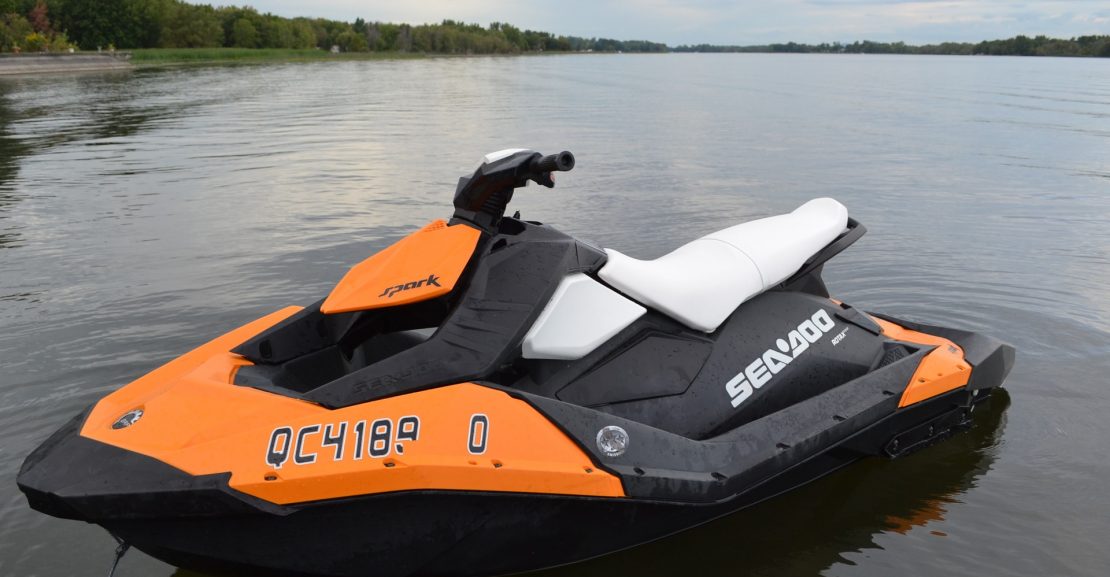Once extremely popular, the personal watercraft segment has been on the decline for several years, with the high cost of fuel being partly to blame. The other reason is the improved technology—while it makes the engines more powerful, it also makes them less affordable. Hence, fewer buyers can move forward with purchase.
Fortunately, BRP is returning to its roots this year with the Spark, a personal watercraft designed to bring the sport back to the masses. With a base price of $6,489 (US$4,999), the Spark proves that having fun on the water need not cost a fortune. And it just happens to be surprisingly fun to drive, with few compromises.
Winning formula
To produce a personal watercraft at this price, BRP’s engineers redesigned the engine from A to Z. And rather than using fibreglass for the hull, they made it out of Polytec, an ultra-resistant polymer. Its advantages include reduced manufacturing costs and lighter weight, which is appropriate for a less powerful (and less expensive) engine. Transporting this craft is also easier, requiring just two people. It can even be towed by a compact car. No need for an SUV!
There’s no mistaking the Spark, not even the first time you see it. Its style marks a distinct break from what we’re used to seeing. The Exoskel hull, made up of two parts screwed together, accounts for its bold lines, especially in front with the transparent mid-section. It seems a little unusual at first, but you get used to it.
To spice up the Spark’s appearance and give it a sportier style, some panels have been painted to contrast with the back hull. There is a wide range of colours available, including some rather extroverted options. Unlike some of the manufacturer’s other models, you can actually personalize your watercraft with various style choices. The other item of good news is that if you hit the dock or otherwise damage the body over time, you can simply replace some of the panels instead of having to repair the fibreglass.
Two engines, two configurations
The Spark can accommodate two passengers at any time, but it can even be transformed into a three-passenger craft thanks to the optional platform and the 3up seat. In terms of mechanics, buyers can choose from two different power levels derived from the three-cylinder Rotax 900 ACE 4-Tec engine taken from the brand’s snowmobiles. In the base trim, it produces 60 horsepower while the High Output version delivers 90. Okay, that may not seem like much compared to the 260 ponies found in modern speedbombs, but let’s not forget the Spark’s aspirations to remain affordable. Plus, it’s lighter, which is an advantage. This modern mill uses a closed-loop cooling system and relays energy to a direct drive jet propulsion system.
We first got acquainted with the Sea-Doo Spark at its introduction, but more recently we had the chance to test a pair of units—one two-passenger and one three-passenger—both equipped with the 90-hosepower HO engine.
We immediately loved the simplicity of the model. It takes just a few seconds to unscrew the two sections of the hull and gain direct access to the mechanical organs, which is much better than peering through a restricted space under the seat. This makes maintenance a whole lot easier, too.
On the water
When you take a seat on the Spark, you discover that it’s a very streamlined model. The instrumentation includes a multifunction display, though there are practically no controls on the handlebars other than the accelerator. There’s a small storage space for a few accessories, but if you want to carry more with you, you’ll have to add the Convenience package, which includes an additional front storage compartment.
On the water, we were delighted by the model’s weight-to-power ratio. While the base trim’s 60 horsepower do a decent job, the additional power of the HO version does the machine a lot more justice. This is where the weight-to-power ratio gets really good. Press the accelerator and the Spark jumps out of the water instantly. It’s even faster when Sport mode is activated, as this improves the accelerator response time. You feel like you’re driving a personal watercraft from the past; it’s so simple, light and easy to maneuver. It’s fun to take it for a splash through the waves or just to take for a jaunt across the water.
We had the chance to discover the Spark at its official launch, but the test drives took place on a small lake. We were wondering how it would perform on larger bodies of water, and the result was very good, indeed. During the test, we found that the 3up version was actually the best option for two people, while the 2up version was more well-suited for a solo driver. The fact that there’s no self-levelling suspension doesn’t pose a problem as the Spark is well-balanced to begin with. On longer rides, especially in the waves, we quickly realized the advantage of bigger models, some of which include a suspension. Guess you can never have it all, can you?
That said, we truly appreciated this model’s fuel economy. We spent the entire weekend out on the water and didn’t have to fork out a fortune on fuel. That’s the Sparks main selling feature!

